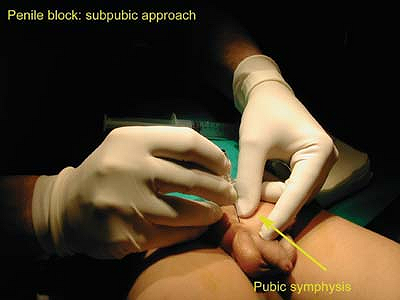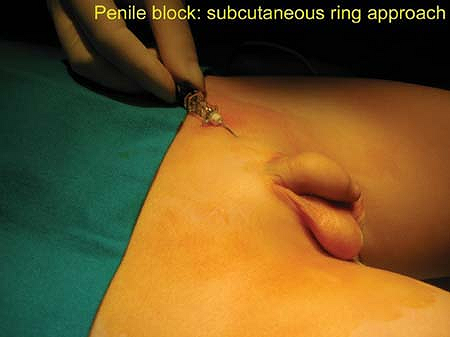Penile Block
Editors: Chelly, Jacques E.
Title: Peripheral Nerve Blocks: A Color Atlas, 3rd Edition
Copyright ©2009 Lippincott Williams & Wilkins
> Table of Contents > Section V – Pediatric Peripheral Blocks > 51 – Penile Block
51
Penile Block
Giorgio Ivani
Valeria Mossetti
Analgesia during and after surface operations on the penis:
circumcision, phimosis; also suitable for pain management following
hypospadia repair, while it is not sufficient for the surgery itself,
caudal anesthesia is preferable.
The penis is pulled downward and two symmetrical sites for needle
insertion are marked, 0.5 to 1 cm both below the pubic symphysis,
lateral to the midline. The short beveled needle is then inserted
vertically pointing slightly caudally until there is a loss of
resistance due to the piercing of Scarpa’s fascia. The two-injection
technique is recommended because the pubic space is frequently divided
into two separate compartments by a medial division.
Another very useful technique is the subcutaneous ring approach.
It is a very simple and successful technique using a subcutaneous ring
of local anesthetic placed around the base of the penis. In this case
no attempt is made to inject local anesthetic within Buck’s fascia,
thus avoiding the risk of compression of the vascular structures when
an excessive volume of local anesthetic is injected within Buck’s
fascia. The points of injection are 2 to 3 cm from the base, at 10 and
2 o’clock level, in the subcutaneous space pointing to the base with
the needle raised superficially injecting a half dose each side,
thereby making a ring of local anesthetic. To complete the ring 1 mL of
local anesthetic should be injected at the base of the penis, in the
ventral part.
It is a very simple and successful technique using a subcutaneous ring
of local anesthetic placed around the base of the penis. In this case
no attempt is made to inject local anesthetic within Buck’s fascia,
thus avoiding the risk of compression of the vascular structures when
an excessive volume of local anesthetic is injected within Buck’s
fascia. The points of injection are 2 to 3 cm from the base, at 10 and
2 o’clock level, in the subcutaneous space pointing to the base with
the needle raised superficially injecting a half dose each side,
thereby making a ring of local anesthetic. To complete the ring 1 mL of
local anesthetic should be injected at the base of the penis, in the
ventral part.
P.358
 |
|
Figure 51-1. Penile block: subpubic approach.
|
 |
|
Figure 51-2. Penile block: subcutaneous ring approach.
|
 |
|
Figure 51-3. Penile block: subcutaneous ring approach.
|
-
The penis is supplied by the two dorsal nerves which cross the subpubic space.
-
The penis is supplied by terminal arteries, therefore epinephrine is contraindicated.
-
The analgesia obtained by this block lasts for a period of at least 24 hours.
Suggested Readings
Broadman
LM, Hannallah RS, Belman AB, et al. Post-circumcision analgesia—a
prospective evaluation of subcutaneous ring block of the penis. Anesthesiology 1987;67:399–402.
LM, Hannallah RS, Belman AB, et al. Post-circumcision analgesia—a
prospective evaluation of subcutaneous ring block of the penis. Anesthesiology 1987;67:399–402.
Dalens B, Vanneuville G, Dechelott P. Penile block via the subpubic space in 100 children. Anesth Analg 1989;69:41–45.
Holder
KJ, Peutrell JM, Weir PM. Regional anaesthesia for circumcision.
Subcutaneous ring block of the penis and subpubic penile block
compared. Eur J Anaesthesiol 1997;14:495–498.
KJ, Peutrell JM, Weir PM. Regional anaesthesia for circumcision.
Subcutaneous ring block of the penis and subpubic penile block
compared. Eur J Anaesthesiol 1997;14:495–498.
